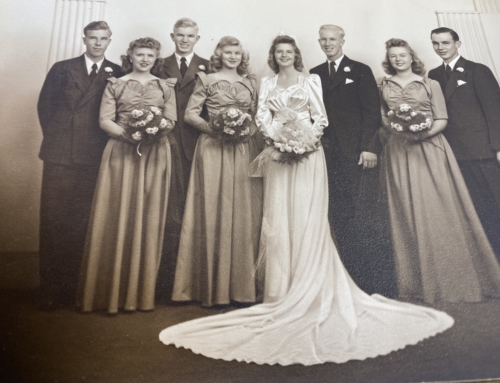The Bible was written to and about real people who lived in real places. But reading these texts today, thousands of years later and thousands of miles apart, can be difficult.

That’s why I found this map in N.T. Wright’s Kingdom New Testament, illustrating the route of the Apostle Paul during his journey described in Acts 16, so encouraging.
Paul’s Route
To quote Acts 16:1-10 (KNT):
1 Paul went on further, to Derbe and then Lystra. There was a disciple there by the name of Timothy, the son of a believing Jewish woman, but with a Greek father. 2 The Christians in Lystra and Iconium spoke well of him. 3 Paul wanted to have Timothy go with them, so he took him and circumcised him because of the Jews in those regions, since they all knew that his father was Greek. 4 When they went through the cities, they handed on to them the decisions which had been taken by the apostles and elders at Jerusalem, so that they could observe them. 5 The churches were strengthened in faith, and grew in number every day.
6 They went through the region of Phrygia and Galatia, since the holy spirit had forbidden them to speak the word in the province of Asia. 7 When they came to Mysia, they tried to go into Bithynia, but the spirit of Jesus didn’t allow them to do so. 8 So, passing by Mysia, they came down to Troas. 9 Then a vision appeared to Paul in the night: a man from Macedonia was standing there, pleading with him, and saying, ‘Come across to Macedonia and help us!’ 10 When he saw the vision, at once we set about finding a way to get across to Macedonia, concluding that God had called us to preach the good news to them.
I love this story because it relates so much to real life, no matter what age we live in.
Notice on the map: Prof. Wright has added question marks on the route that Paul and his companions traveled.
Does this mean we don’t know what the route was? No.
This map illustrates the puzzle that Paul and his fellow travelers faced in deciding where to go next.
At one point, when they tried to go into Bithynia, ‘the spirit of Jesus did not allow them to do so’ (Acts 16:7).
Now I have a question! How did they know that? Of course, we are not told how they figured this out.
We are only let into the reality of the message from God via the Holy Spirit: don’t enter Bithynia. And we also wonder how ‘the Holy Spirit had forbidden them to speak the word of God in Asia’. And maybe we would also ask ‘Why?’ the Holy Spirit would not want the word to enter Asia.
The word of God eventually penetrates Asia and Bithynia, but not on this trip with Paul and his companions. We finally find out the reason: they needed to be in Macedonia.
I wonder what the conversations were like when it seemed that they should not enter Asia or go to Bithynia?
Were there arguments about where they should go? Did they have a prayer meeting and wait? Did they cast lots? Or was there the convergence of prayer, worship, thought, circumstances, and maybe a prophetic utterance?
I think it is good that we are not told exactly what it looked like. We just know that they were willing to hear the Spirit’s voice and do what He said.
Following Paul’s Map and Charting our own Course Click To TweetMy Route
Four years ago, I was in that place where the Lord had clearly called me out of my role of pastor in a congregation where I served 33 years. The Lord, by the Holy Spirit, through the study of Scripture, as well as through godly counsel, had said, ‘Leave your pastoral job…and I will show you where to go’.
So, I resigned. I had no job prospects, no academic posts open to fill, nobody had offered me a job upon leaving. I knew I was to wait, pray, listen, and knock on the doors God showed me.
The process led me to listen carefully to what seemed to be the answer: Start an educational non-profit organization to help transform people through the renewal of their minds using high quality biblical and theological education.
In my case, it was not a vision, but it was the confluence of prayer, wise counsel, seeing a glaring need, and a willingness to trust that, even if this is not the final destination, it is the next destination.
Thus, the non-profit organization was formed and now, nearly four years later, we have around 14,000 students from 151 countries studying top-quality biblical and theological education through the ministry of N.T. Wright Online, as well as through local initiatives.
But, if we return to the Acts of the Apostles, we know that Paul is determined that the final destination would be Spain. In Acts 16, he isn’t told to go to Spain, just to Macedonia. There was the long-term desire as well as the short-term obedience to the call to go to Macedonia.
Your Route
The question marks along our own maps are not places where we or God has failed. They are times to wait, pray, seek counsel, hear God, and, by faith, walk to what seems to be the next step. Incidentally, Paul never makes it to Spain. But in the process of going to Spain he eventually gets to Rome to bring news of the King before the emperor. He dies a martyrs death, full of faith and with the knowledge that he was following his King.
Perhaps we should not be so panicked when the question marks come along our paths. We should know that God will lead us. We may not know the next destination.
In an era where people make strategic plans (not a bad thing), we should allow the Holy Spirit the ‘veto power’ over those plans to do what He wishes rather than simply our own plans.
Paul’s determination at so many points was evident: He knew what he was doing and where he wanted to go. But then, when God gave him an unexpected ‘pause’, he waited for direction before proceeding. Question marks can be good to slow us down to seek His path and it may not be the one we assumed it would be.
How will you chart your path?
Our next course, The Acts of the Apostles, will release on September 22nd! When you download this free eBook, you’ll get a discount on the purchase of the course.
David P. Seemuth, PhD
Latest posts by David P. Seemuth, PhD (see all)
- Advent Reflections from the N.T. Wright Online Team - December 5, 2022
- YouTube as Public Reading of Scripture - August 29, 2022
- What I Learned From A Week With Professor Wright - June 16, 2022





![[Video] There’s more to ‘joy and peace’ than you might think](https://www.ntwrightonline.org/wp-content/uploads/2021/03/tamara-menzi-HQ_Vh1fSWHk-unsplash-500x383.jpg)
